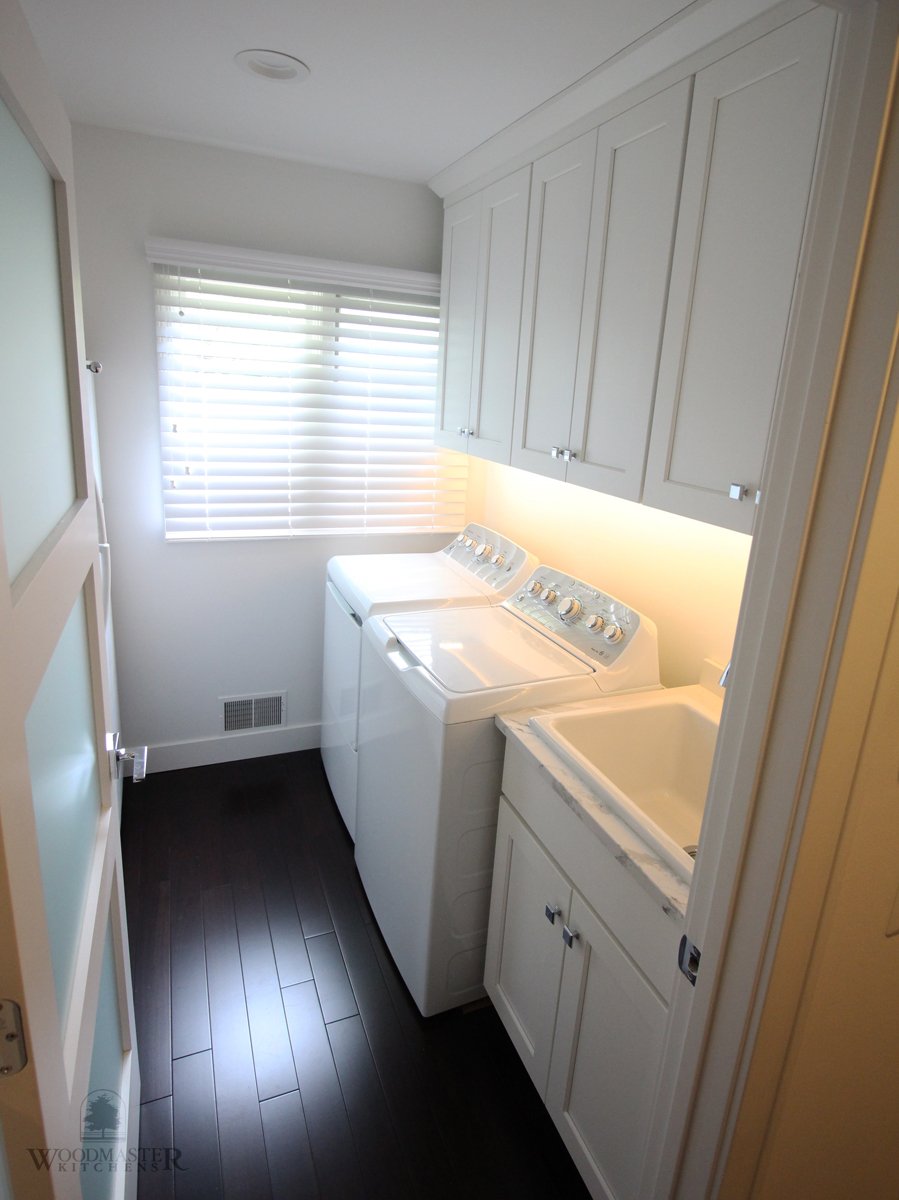Design Your Ideal Custom Laundry Room
A kitchen remodel is the perfect opportunity to go through your wish list of requirements and include them in your new kitchen design plans. While you are planning for a remodel and working with a design and remodeling team, why not look at other adjacent spaces that would benefit from a fresh design, enhanced storage, and updated style. This could include updating your hall flooring, adding a walk-in pantry, or enhancing your powder room design.
A laundry room is a huge asset to a home that can be easily added to a kitchen remodel, and it is even better when customized to your exact needs. A design that allows you to wash, dry and sort laundry in one convenient space saves you valuable time and increases the value of your home.
If you’re remodeling to sell, you can keep your laundry room neutral to appeal to all tastes. On the other hand, if you plan to stay in your home, then customizing your design lets you create a space to suit your own style and enhance functionality. Whether you need to increase storage or decrease noise levels, working with a design and remodeling expert results in a laundry room that works for you.
Whether you’re starting from scratch or remodeling an existing space, read on to discover how to design your ideal custom laundry room.
Where Do I Start?
A laundry room design is like a scaled down version of a kitchen design in that it includes plumbing, storage, workspace, and appliances. First, think about how you’ll be using the laundry room to assess your requirements. How many people will it be facilitating? Is this a multi-purpose space that you also plan to use for extra pantry storage or to keep a spare freezer? Would you like a large sink for tasks such as bathing pets or washing sports equipment? How much space do you need to iron and hang clothes to dry? When you have figured this out then see if you can include other functions, such as bike storage or space for boots and school bags.
Your laundry room needs to be big enough for your washing machine and dryer with a few inches behind and a couple of feet clearance in front for a front-loading machine. Make an allowance in case you decide to upgrade to larger models in the future. Make sure you have at least one exterior wall with ventilation, preferably including a window. Your laundry room needs to be plumbed with hot and cold water and a strong electricity supply. Plan where you’d like your power points to be for maximum efficiency. Floor drainage can be installed along with an automatic power shut down in case there is a leak.
Once you have sorted out practicalities, choose storage and countertops that suit your taste and work well with the rest of your home’s interior design. This is even more important if your laundry room is in a prominent location like near a back door to your home or adjacent to your kitchen design.
What Else Can I Use My Laundry Room For?
Apart from laundry needs, your new space can be used in many different ways. Make your design multifunctional by including a utility space such as a mud room. Assign tailor-made storage for coats and boots along with somewhere to let them dry. A pet shower to clean dogs after a walk and somewhere to sit while taking off boots are all things that can be included at the design stage. If your large, multi-purpose laundry room is doubling as a pantry, it should have storage and countertop space that is separate to the laundry workspace. You could even install a dishwasher, fridge-freezer and sink along with pantry storage in this multi-functional room.
Where Should I Locate My Laundry Room?
Connecting a laundry room to your kitchen design makes it easier to access plumbing and electricity and leaves it conveniently located to change laundry or check on drying clothes.
However, there are other places that might work better depending on your home’s layout and your lifestyle. You could take a section of your garage to build your laundry room or consider placing it beside a large bathroom.
Don’t confine yourself to the first floor. A laundry room could be located upstairs if you choose appliances with low decibel ratings and control any noise with rugs and a solid door. Basements are another place traditionally used for laundry facilities, Try to keep any laundry room beside a window for natural light and ventilation, making it a safer and nicer place to be.
Which Layout Should I Choose?
Your choice of layout depends largely on the size and shape of your laundry perimeter.
An L-shaped layout means you can put a sink or mudroom at one end while the washer and dryer are easily accessible at the entrance side.
A single wall layout works well for most laundry rooms as it confines all the plumbing to one wall. By installing the washer, dryer, sink and cabinets along one wall you can easily navigate the space.
Or create a galley layout with the appliances on one side and extra cabinet storage on the opposite wall. Make use of your overhead space in this design and store laundry baskets and other essentials on shelving.
If space is no issue, then include an island in your layout to provide more storage and workspace
The layout of your laundry room design affects its efficiency and aesthetic.
What Do I Need in My Laundry Room?
Prioritize the tasks you need to perform in a laundry room remodel. This makes for a high-performance design that caters to your needs. Your layout should include work surfaces and appliances that are arranged in a way that makes sense as you move around the room. An example of good workflow in a laundry room would be to have the washer and dryer together with a countertop where you can fold clothes. A clothes rod for hanging could be underneath a shelf that stores laundry essentials. A nearby prep sink means handwashing is included in this work area.
Fold-out ironing boards are clever space savers if you have limited room. There are also efficient ways to sort and dry your laundry. Tilt-out laundry containers can fit into an allocated space in your laundry room cabinets. Clothes racks on casters move around, while pull-down ceiling racks and wall-mounted clothing valets can retreat back into their storage position when not in use. Ensure that your flooring is waterproof, low maintenance, and preferably heated, for extra drying power.
What Kind of Storage Works Best in a Laundry Room?
The style of the storage you choose for your laundry remodel should complement the rest of your interior design. If your laundry room is connected to your kitchen, you should choose cabinets that are in the same style. If your design is on the smaller side, then choose light-colored cabinet doors in a glossy finish to make your space appear larger. Keep the look streamlined with handleless cabinetry and integrated appliances. Opt for a combination of open and closed storage and customize storage to keep long narrow items such as brooms, ironing boards, and vacuum cleaners neatly stowed. Include shelves at different heights, placing toxic items on higher shelves out of children’s or pets’ reach. Install task lighting under cabinets and shelving to illuminate your countertops.
Is There a Specific Way to Style a Laundry Room?
The most important thing is to keep your laundry room stylish as well as functional or you will dread spending time there and it will add nothing to your home. There are different looks, from coastal to farmhouse, but the style you choose should work with the rest of your home’s decor. It should also blend seamlessly into any space to which your laundry room is attached. Start with the bare walls and make them inviting and warm. You can paint your laundry room a soft shade or enliven it with richly patterned wallpaper. Hang pictures, mirrors and even a tv to watch as you iron. Always take into account how you use a room before you style it.
If you have a window in your laundry room, don’t neglect it. Dress it with curtains, blinds or shutters to suit your style. Other soft furnishings, such as low-pile rugs, lampshades or ironing board covers, should tie in with the colors, patterns and textures in your design. Keep some space for non-functional items on shelving. Plants and curios can bring personality to any space. Look at all details from cabinet hardware to light switches to take your laundry room to the next level. Decant laundry supplies into containers that suit the style of your remodel and store canned goods in deep drawers. Your laundry room should be an uncluttered and well-planned space.
If you consider these design aspects at the planning stage of your remodel, then you can avoid many pitfalls. A design expert can work with you from planning to installation to ensure that your laundry room remodel is customized to perform to the best of its ability and enhance your home. At Woodmaster Kitchens, we take you through each step of the design process, listening to your requirements. Why not contact us today to get started?



